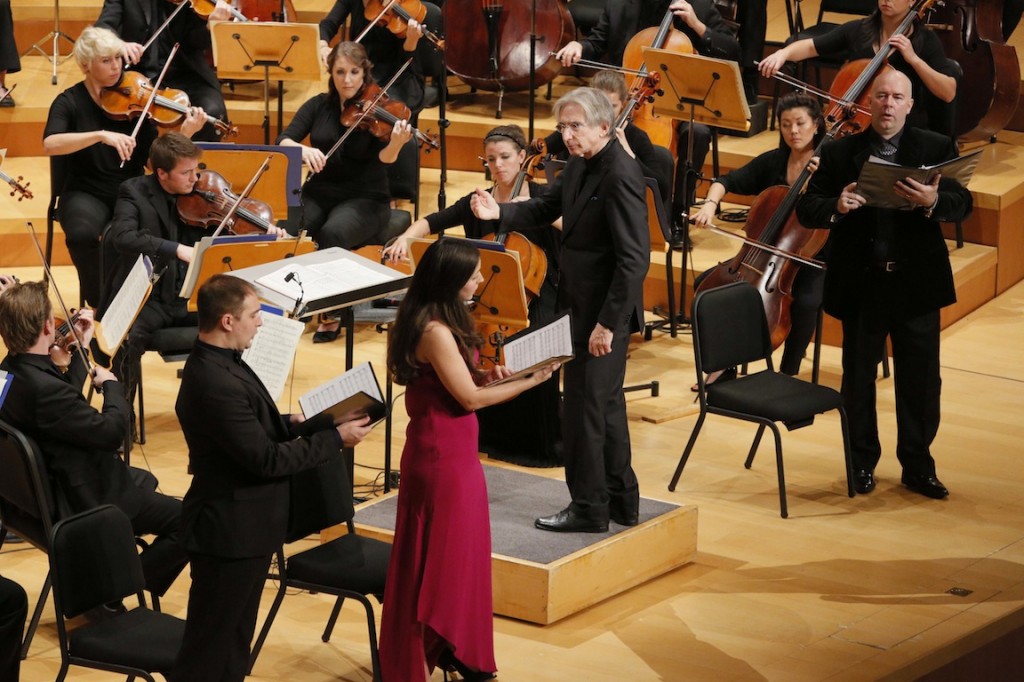New World Symphony mixes it up with 20th-century, multimedia program

Michael Tilson Thomas conducts the New World Symphony in Stravinsky’s “Pulcinella” Thursday night with soloists Matthew Newlin, Peabody Southwell and Rod Nelman. Photo: Rui Dias-Aidos
The New World Symphony previewed a challenging program before a full and unusually attentive house Thursday night. Miami Beach’s orchestral academy will be taking a road trip to Chicago to perform the same program Saturday night.
In the spirit of Frank Gehry’s architecturally stunning New World Center, the concert featured the work of theatrical director, designer and filmmaker Netia Jones in concert with the music of Italian avant-gardist Niccolo Castiglioni. (Jones’ production was jointly commissioned by NWS and Chicago’s Harris Theater.) While the combination of aural and visual arts did not always work to the benefit of the music, the presentation was never less than stimulating and exemplified the innovative and adventurous spirit that the orchestra will be bringing to the Windy City.
Educational outreach has long been a facet of the New World program with players acting as teachers and mentors to local instrumental students. Nine student players from Miami’s New World School of the Arts and other South Florida performing arts schools joined their mentors for a sampling of Luciano Berio’s Duets for Two Violins.
These miniatures find the experimental twentieth-century icon in a gentler, more populist musical frame. Italian melodies and dance forms cross paths with Bachian counterpoint and touches of modernist angularity in these ingenuous works.
Berio’s string writing does not shy away from complexity and high marks go to the well prepared students and their mentors for playing with such flair and polish. With the musicians arranged on platforms at the sides and back of the stage, Michael Tilson Thomas led the entire group in the final piece, drawing precise articulation and finely blended ensemble from the eighteen violins.
If Berio had written The Nutcracker, Castiglioni’s Inverno In-ver (“Winter in truth”) is what it may have sounded like. A student of the Darmstadt summer academy, the hub of such modernists as Berio and Stockhausen, Castiglioni was an iconoclast who mixed serialism with a more tonal palette. High pitched, animated thematic particles seem to dance through Castiglioni’s delightful score. Sudden bursts of Tchaikovskian melody are met with stringent, often piercing dissonance from combinations of winds, violins, piano and xylophone.
The shimmer of harp and strings turns soft and somber near the work’s conclusion, the final winter of death vividly etched. Castiglioni combines the spare textures and delicacy of Anton Webern with a distinctively Italianate personality. Tilson Thomas and the ensemble reveled in the score’s wild infusions of rhythm and color, an enticing mix of old and new.
Jones’s video projected squares and rectangles at various angles over the stage and side walls, mirroring her sculptures behind the orchestra. Changing shades and patterns attempted to follow the music’s shifting timbres Most effective were the projected leaves and snowflakes as the music became hushed and elegiac. The presentation was eye-filling, in many ways an arty, high-tech version of 1960’s psychedelic productions.
Still, Castiglioni’s wildly original piece can stand well enough on its own and all the visual creations distracted from the music. Jones’ staging was even more distracting and unnecessary. Individual players and whole sections constantly stood or wandered the stage, a group of string players at one point about to exit at the suggestion of a Christmas carol in mallet percussion. The audience seemed to enjoy all the multimedia pyrotechnics, awarding Jones an enthusiastic ovation.
Many audience members left at intermission, missing the rare opportunity to hear a live performance of the complete score for Stravinsky’s ballet Pulcinella with the vocal parts rather than the familiar, abbreviated orchestral suite.
Stravinsky’s refraction of melodies by Pergolesi and other obscure eighteenth-century composers is even more enchanting when heard in full. This music seems to be in Tilson Thomas’ veins. Eschewing balletic niceties, he led a tightly concentrated reading, emphasizing tart harmonies and incisive rhythms, more in the vein of a Stravinsky symphony.
The winds excelled in a graceful gavotte and variations, the string tone consistently sweet and pliant. Only the New World horns seemed to be having a bad night with consistent fluffs.
Mezzo-soprano Peabody Southwell’s warmly burnished timbre and impeccable sense of classical style graced two solos. Matthew Newlin’s refined lyric tenor beautifully encompassed the high writing of the serenade and the robust baritone of Rod Nelman blended well in several trio sections with his colleagues.
The New World Symphony repeats the program 8 p.m. Saturday at the Harris Theater in Chicago. Students from the Music Institute of Chicago will be featured in Berio’s Duets 312-334-7777; harristheaterchicago.org.
Posted in Performances
Leave a Comment
Fri Oct 18, 2013
at 1:03 pm
No Comments